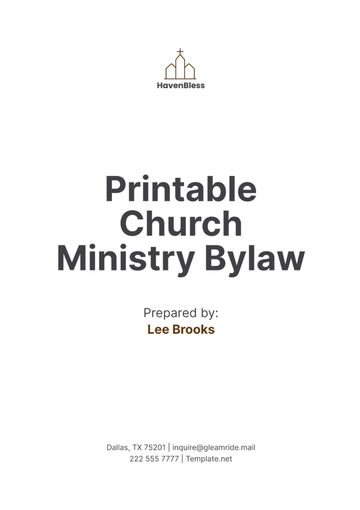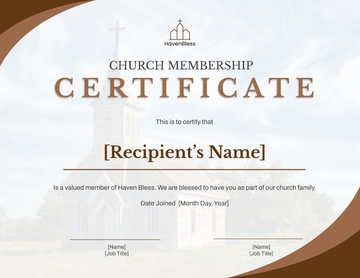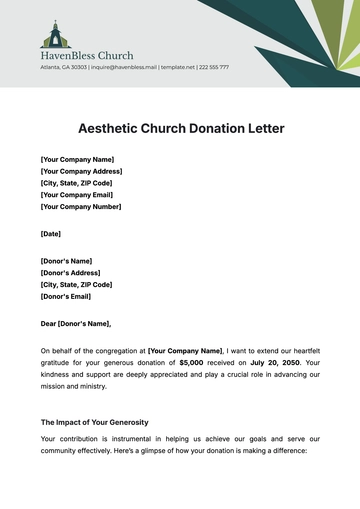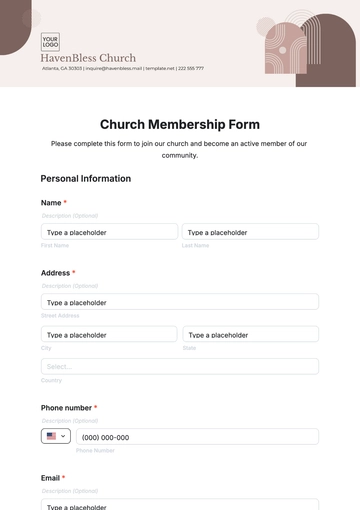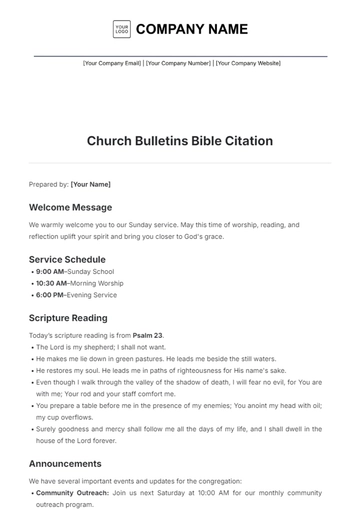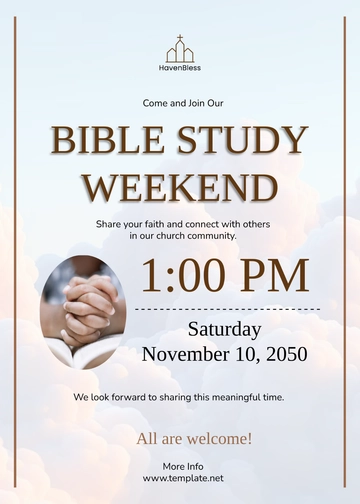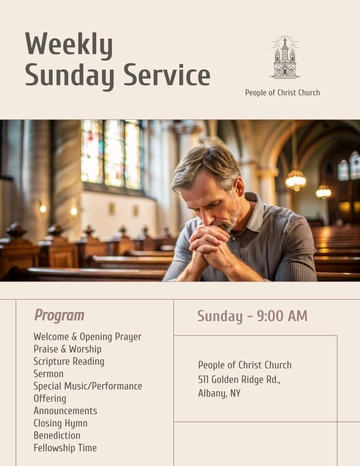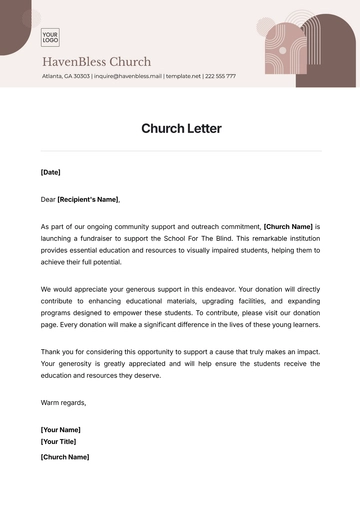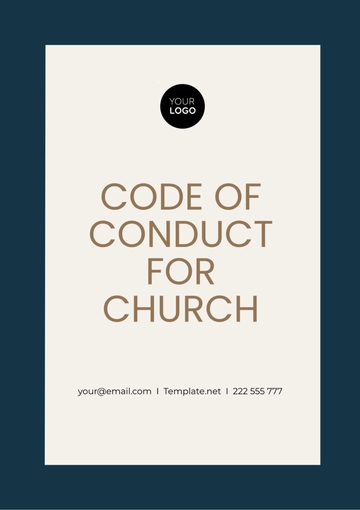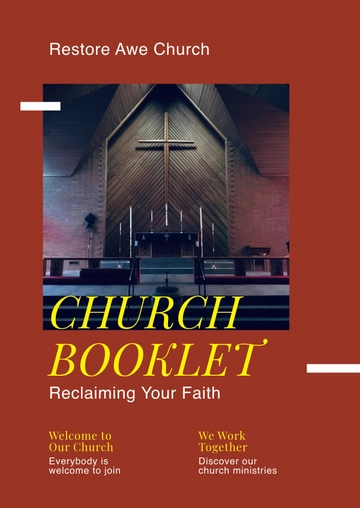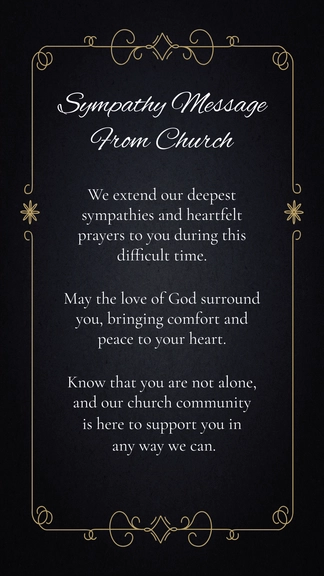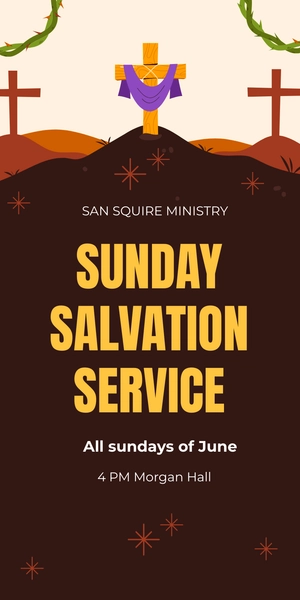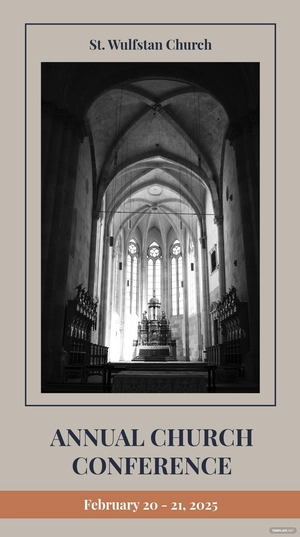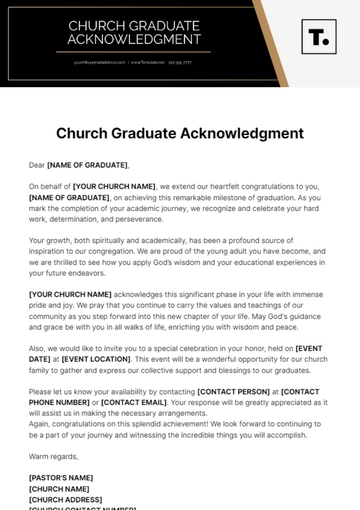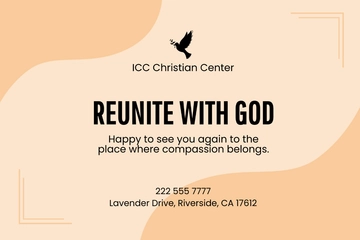Free Simple Church Apostolic Bylaw
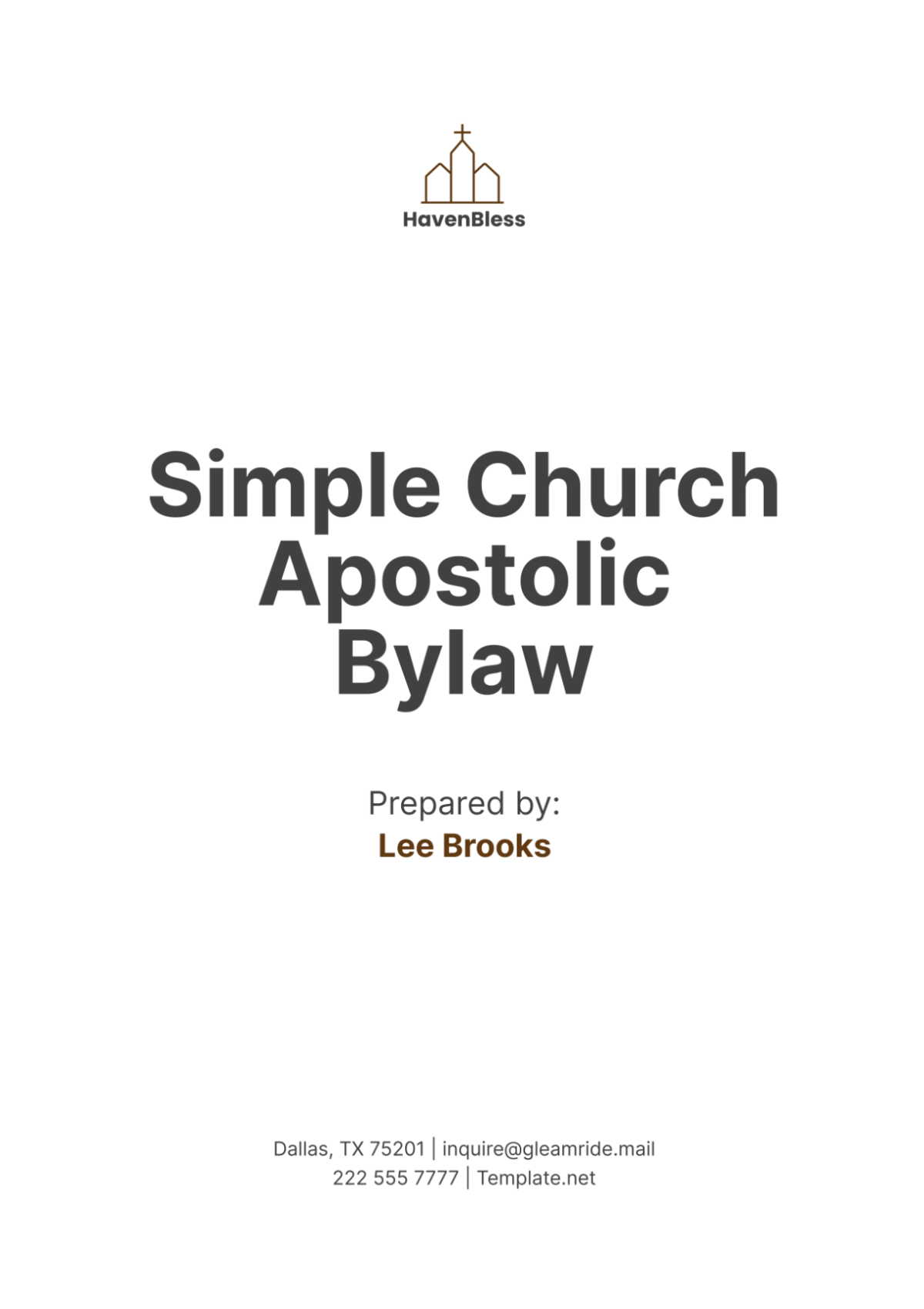
I. Introduction
A. Purpose of the Bylaw
The bylaws of [Your Company Name] serve as the foundational document governing the operations, management, and conduct of the church. They outline the principles and procedures that guide the church's activities, ensuring that all aspects of church life are conducted in an orderly and consistent manner. The purpose of these bylaws is to provide clarity on the governance structure, define roles and responsibilities, and establish protocols for decision-making and membership.
B. Church Information
Name of Church: | [Your Company Name] |
Address: | [Your Company Address] |
Contact Details: | [Your Company Number] [Your Company Email] |
II. Statement of Faith
A. Core Beliefs
At [Your Company Name], our beliefs are rooted in the teachings of the Bible, and we adhere to a set of core doctrines that shape our faith and practice. Our core beliefs include the following:
The Trinity: We believe in one God who exists in three persons: God the Father, God the Son (Jesus Christ), and God the Holy Spirit. Each person is fully God, yet there is only one God.
The Bible: We hold the Bible to be the inspired, inerrant, and authoritative Word of God. It serves as the ultimate guide for our faith and practice.
Salvation: We believe that salvation is by grace through faith in Jesus Christ. Jesus’ death and resurrection provide the means for humanity to be reconciled with God.
The Church: The church is the body of Christ on earth, called to worship God, teach His Word, and serve others. It is essential for spiritual growth and community.
The Second Coming: We anticipate the return of Jesus Christ, who will establish His kingdom and judge the living and the dead.
B. Scriptural Basis
Our beliefs are firmly grounded in Scripture. The following biblical passages provide the foundation for our core doctrines:
The Trinity: Matthew 28:19, 2 Corinthians 13:14
The Bible: 2 Timothy 3:16-17, Psalm 119:105
Salvation: Ephesians 2:8-9, John 3:16
The Church: Ephesians 4:11-13, Hebrews 10:24-25
The Second Coming: Acts 1:11, Revelation 19:11-16
III. Organizational Structure
A. Leadership Roles
The governance of [Your Company Name] is structured to ensure effective leadership and spiritual oversight. The primary leadership roles include:
Apostolic Leadership: This role encompasses the oversight of the church’s spiritual direction, including preaching, teaching, and providing guidance to the congregation. The Apostolic Leader is also responsible for representing the church in broader denominational and community matters.
Elders: Elders are responsible for the pastoral care of the church, including counseling, visitation, and support for the congregation. They work closely with the Apostolic Leadership to ensure the church’s needs are met.
Deacons: Deacons handle the operational aspects of the church, including managing church finances, facilities, and administrative tasks. They support the Elders and Apostolic Leadership in executing the church’s mission.
B. Appointment and Removal of Leaders
Appointment: Leaders are appointed based on their spiritual qualifications, experience, and alignment with the church’s mission. The appointment process involves nomination by current leaders, approval by the church membership, and formal commissioning.
Removal: A leader may be removed from their position for reasons including moral failure, doctrinal deviation, or failure to fulfill their duties. The process for removal involves a review by a committee, followed by a vote by the church membership.
C. Decision-Making Process
Decisions within [Your Company Name] are reached through a methodical and collaborative process that involves the Apostolic Leadership, the Elders, and the Deacons. This teamwork ensures that a diverse set of perspectives is taken into account, resulting in well-rounded and robust decision-making. When it comes to major decisions—such as the approval of budgets and changes to core doctrines—these require not only the consensus of the entire leadership team but also a majority vote from the broader church membership. This dual-layered approach ensures that significant choices reflect both the informed guidance of the leaders and the collective will of the church community.
IV. Membership
A. Eligibility for Membership
Membership at [Your Company Name] is open to individuals who have made a personal commitment to Jesus Christ and who are in agreement with our Statement of Faith. Prospective members must:
Complete a Membership Class: This class provides an overview of the church’s beliefs, practices, and expectations for members.
Provide a Testimony of Faith: Individuals must share their personal testimony and commitment to Jesus Christ.
Meet with a Membership Committee: This committee will review the individual’s suitability for membership and answer any questions they may have.
B. Rights and Responsibilities
Rights: Members have the right to participate in all church activities, vote on key decisions, and receive pastoral care.
Responsibilities: Members are expected to attend services regularly, contribute financially to the church, participate in church ministries, and uphold the church’s values and standards.
C. Termination of Membership
Voluntary Termination: Members may resign their membership by submitting a written notice to the church office.
Involuntary Termination: Membership may be terminated for reasons including prolonged absence, failure to adhere to church standards, or moral failure. This process involves a review by the leadership team and a formal decision by the church membership.
V. Meetings and Worship Services
A. Regular Services
[Your Company Name] holds regular worship services every Sunday and on special occasions. The schedule includes:
Sunday Services: Held at [Insert Time], these services include worship, preaching, and fellowship. These services are central to the church’s mission, providing a weekly opportunity for congregational worship and community building.
Midweek Services: Includes Bible studies, prayer meetings, and small group gatherings. These services are designed to foster deeper spiritual growth and provide additional opportunities for members to engage with the church community.
Special Services: Such as Christmas and Easter services, community outreach events, and other special occasions. These services celebrate key events in the Christian calendar and provide opportunities for broader community engagement.
B. Special Meetings
Special meetings are convened as needed for:
Annual General Meetings: To review the church’s activities, finances, and future plans. The annual meeting is a key opportunity for members to engage with the leadership on the church’s progress and future direction.
Emergency Meetings: To address urgent matters that require immediate attention. Emergency meetings may be called to handle unforeseen situations or crises impacting the church.
C. Meeting Procedures
Meetings at [Your Company Name] are conducted according to the following procedures:
Notification: Members are notified of meetings at least two weeks in advance. Notifications are made via email, physical notices, and announcements during services to ensure maximum attendance.
Agenda: A detailed agenda is prepared and distributed prior to the meeting. The agenda outlines the topics to be discussed and ensures that meetings are conducted efficiently.
Minutes: Minutes are recorded and made available to the congregation. Minutes provide a formal record of the meeting’s proceedings and decisions made.
Voting: Decisions are made by majority vote, with specific procedures for handling disputes and objections. Voting procedures ensure that all members have a voice in key decisions affecting the church.
VI. Financial Management
A. Budget and Finance Committee
The Budget and Finance Committee is responsible for:
Preparing the Annual Budget: Includes forecasting income and expenses, and aligning the budget with the church’s mission and goals. The committee ensures that the budget reflects the church’s priorities and is managed effectively.
Overseeing Financial Transactions: Ensures that all financial transactions are conducted transparently and in accordance with church policies. This includes monitoring expenditures, managing donations, and ensuring compliance with financial regulations.
Reviewing Financial Reports: Regularly reviews financial statements and reports to ensure accuracy and accountability. The committee provides oversight and makes recommendations for financial improvements.
B. Funding and Donations
Accepting Donations: Donations are accepted from members and external sources, including online contributions, cash, and in-kind gifts. The church provides multiple avenues for giving to accommodate the preferences of donors.
Managing Funds: Funds are managed according to established financial procedures, including proper documentation and tracking. This ensures that all donations are used in accordance with the church’s mission and legal requirements.
C. Financial Reporting
Regular Reports: Financial reports are prepared monthly and reviewed by the Budget and Finance Committee. These reports provide a snapshot of the church’s financial status and help in making informed decisions.
Annual Audit: An annual audit is conducted by an external auditor to ensure financial integrity and compliance with legal requirements. The audit provides an independent assessment of the church’s financial practices and statements.
VII. Amendments to Bylaws
A. Procedure for Amendments
Proposal of Amendments: Amendments to the bylaws may be proposed by the Apostolic Leadership, Elders, or a group of members. Proposals must be submitted in writing and include a rationale for the change.
Review and Discussion: Proposed amendments are reviewed and discussed by the leadership team and the congregation. This process ensures that all viewpoints are considered before a decision is made.
B. Approval Process
Voting: Amendments are approved by a two-thirds majority vote of the church membership. Voting takes place during a specially convened meeting or as part of the annual general meeting.
Implementation: Approved amendments are implemented immediately, with updated bylaws provided to all members. The church ensures that all members are informed of changes and how they affect church operations.
VIII. Conflict Resolution
A. Mediation Process
Initial Steps: Conflicts among members or between members and leadership are initially addressed through direct communication and mediation. Members are encouraged to resolve issues amicably through open dialogue and mutual understanding.
Formal Mediation: If initial steps fail, formal mediation is conducted by a designated mediation team or external mediator. The mediator facilitates discussions to help parties reach a mutually acceptable resolution.
B. Appeals Process
Filing an Appeal: Members who are dissatisfied with the mediation outcome may file a formal appeal. Appeals must be submitted in writing and include specific details of the disagreement and desired resolution.
Review and Decision: The appeal is reviewed by a designated appeals committee, which makes a final decision based on the facts presented and church policies. The decision of the appeals committee is final and binding.
C. Dispute Resolution Procedures
Documentation: All disputes and resolutions are documented to ensure transparency and accountability. Documentation includes details of the conflict, steps taken to resolve it, and the final outcome.
Follow-Up: The church conducts follow-up to ensure that the resolution is effective and that no further issues arise. Follow-up actions may include additional meetings, support, or adjustments to policies.
IX. Termination of the Church
A. Dissolution Procedure
Decision to Dissolve: The decision to dissolve [Your Company Name] must be made by a two-thirds majority vote of the church membership. This decision is based on factors such as financial instability, inability to fulfill the mission, or other significant issues.
Notification: Members, staff, and stakeholders are notified of the decision to dissolve, along with the reasons and timeline for the dissolution. Notifications are made through official communications, including letters and meetings.
B. Asset Distribution
Settling Debts: All outstanding debts and obligations are settled before distributing any remaining assets. This includes paying off creditors, fulfilling contractual obligations, and resolving any financial liabilities.
Distribution of Assets: Remaining assets are distributed according to the church’s established policies or as required by law. Assets may be transferred to a similar organization, donated to charitable causes, or otherwise allocated as decided by the membership.
C. Final Reporting
Final Report: A final report is prepared, detailing the dissolution process, financial status, and distribution of assets. This report provides a comprehensive account of the church’s closure and ensures transparency.
Archiving Records: All church records are archived for historical and legal purposes. This includes financial records, meeting minutes, and other important documents.
X. Conclusion
A. Acknowledgment
By adhering to these bylaws, [Your Company Name] ensures that its operations are conducted with integrity, transparency, and in accordance with its mission and values. These bylaws provide a framework for effective governance and ensure that all members and leaders understand their roles and responsibilities.
B. Adoption
These bylaws are adopted by the church membership and serve as the governing document for [Your Company Name]. They are reviewed and updated as necessary to reflect changes in the church’s needs and the broader community.
- 100% Customizable, free editor
- Access 1 Million+ Templates, photo’s & graphics
- Download or share as a template
- Click and replace photos, graphics, text, backgrounds
- Resize, crop, AI write & more
- Access advanced editor
Create a comprehensive set of bylaws with Template.net's customizable and editable Simple Church Apostolic Bylaw Template. Using the Ai Editor Tool, tailor it to fit your church's specific needs, ensuring clarity and compliance. Ideal for establishing governance and organizational structure within your congregation.
